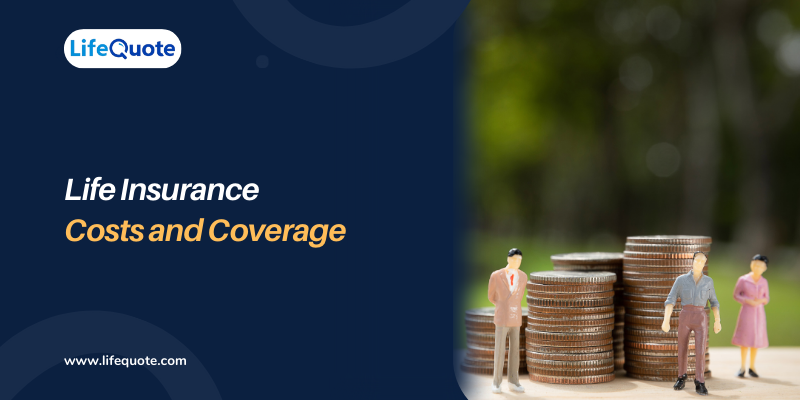- Speak to a licensed sales agent!
- (800) 521-7873
What Are The Typical Term Life Insurance Rates?

term life insurance rate
When considering life insurance, many questions come to mind: How much does life insurance cost? How are the rates calculated? What things affect the price of term life insurance? This guide aims to answer these questions and more, providing a comprehensive look at typical term life insurance rates and what influences them.
How Much Does Life Insurance Cost?
The cost of life insurance varies significantly based on several factors, but on average, term life insurance is relatively affordable. Term life insurance rates by age for policies provide coverage for a specific period, usually 10, 20, or 30 years, and are generally less expensive than whole life insurance policies.
- Term Life Insurance: For a healthy non-smoker in their 30s, a 20-year term policy with a $500,000 death benefit might cost between $20 and $30 per month.
- Whole Life Insurance: This type of policy is more expensive because it provides lifetime coverage and includes a savings component. The same individual might pay between $200 and $300 per month for a whole life policy with a $500,000 death benefit.
Calculation of Life Insurance Rates
Life insurance companies use several factors to calculate your premium. The process involves actuarial science, where statisticians and mathematicians assess risk based on various criteria.
- Age: Younger individuals typically pay lower premiums because they are statistically less likely to die within the term of the policy.
- Health: Insurers assess your health through medical exams and questionnaires. Chronic conditions or a history of serious illnesses can increase premiums.
- Lifestyle: Habits like smoking or engaging in dangerous activities (e.g., skydiving) raise your risk profile and, consequently, your premiums.
- Coverage Amount and Term Length: Higher coverage amounts and longer terms cost more because the insurer’s potential payout is higher.
Factors Affecting The Cost of Term Life Insurance
To figure out the cost of your life insurance, follow these steps:
- Gender: Statistically, women live longer than men, resulting in lower premiums for women.
- Occupation: Jobs with higher risks (e.g., construction work) can increase premiums.
- Family Medical History: A family history of diseases like cancer or heart disease can raise your rates.
- Policy Features: Additional features like riders (e.g., critical illness riders) can increase premiums.
How Does Your Life Insurance Premium Not Impact?
Certain factors surprisingly do not impact your life insurance premiums directly, including:
- Geographic Location: Unlike car insurance, where your location can affect rates, life insurance premiums are generally unaffected by where you live.
- Credit Score: While important for other types of insurance and loans, your credit score does not directly influence life insurance premiums.
- Marital Status: Whether you’re single, married, divorced, or widowed does not directly impact your life insurance rates.
Calculating The Cost Of Your Life Insurance
To calculate the cost of your life insurance, follow these steps:
- Determine Coverage Needs: Assess how much coverage you need by considering your financial obligations, such as mortgage, debts, and future expenses like college tuition.
- Compare Quotes: Use online tools to compare quotations for life insurance from multiple insurers.
- Consider Policy Terms: Decide on the term length that best suits your needs (e.g., 10, 20, or 30 years).
- Understand the Policy: Ensure you understand the terms, conditions, and any riders included.
Rates For Term Life Insurance Based On Age

Age is one of the most important factors that affect term life insurance rates. Here’s a breakdown of typical monthly premiums for a $500,000 policy:
- Age 25: Approximately $20 per month
- Age 35: Approximately $25 per month
- Age 45: Approximately $60 per month
- Age 55: Approximately $150 per month
- Age 65: Approximately $400 per month
How Much Whole Life Insurance Costs Based On Your Age
Whole life insurance costs more than term life insurance because it offers lifelong coverage and includes a cash value component. Here’s a typical monthly premium breakdown for a $500,000 policy:
- Age 25: Approximately $300 per month
- Age 35: Approximately $350 per month
- Age 45: Approximately $500 per month
- Age 55: Approximately $750 per month
- Age 65: Approximately $1,200 per month
Additional Factors to Consider
When choosing life insurance, it’s important to consider the following additional factors to ensure you get the best value and coverage:
1. Health Improvement Options
If you improve your health after purchasing a policy (e.g., quitting smoking or losing weight), some insurers may allow you to retake the medical exam and lower your premiums.
2. Policy Riders
Riders are extra features you can add to your policy for additional benefits. Common riders include:
- Accelerated Death Benefit: Lets you get part of your death benefit early if you’re diagnosed with a terminal illness.
- Waiver of Premium: Waives your premium payments if you become disabled and unable to work.
- Renewability and Convertibility
- Renewable Term Life Insurance: Some term policies are renewable, meaning you can extend the coverage without a medical exam, but at a higher premium.
- Convertible Term Life Insurance: Allows you to convert your term policy to a whole life policy, often without a medical exam.
- Financial Strength of the Insurer
Choose a term life insurance company with strong financial ratings to ensure they can pay out claims when needed. Look for ratings from agencies like A.M. Best, Moody’s, and Standard & Poor’s.
The Impact of Policy Duration on Cost

The length of your policy term also affects the cost. Shorter terms are cheaper but may not provide coverage when you need it most.
- 10-Year Term: Lower premiums but may expire before significant financial obligations (e.g., children’s college tuition) are paid off.
- 20-Year Term: Balances cost and coverage duration, ideal for young families.
- 30-Year Term: Higher premiums but offers long-term security, suitable for those with longer financial commitments.
Comparing Term Life Insurance to Whole Life Insurance
Understanding the differences between term and whole life insurance can help you make an informed decision:
- Term Life Insurance: Lower initial cost, fixed premium, no cash value, expires at the end of the term.
- Whole Life Insurance: Whole life insurance has a higher initial cost but offers benefits like building cash value, lifelong coverage, and fixed premiums.
How to Get the Best Rates

To secure the best rates for your life insurance:
- Start Early: The younger you are when you purchase a policy, the lower your premiums.
- Maintain Good Health: Regular exercise, a balanced diet, and avoiding smoking can help you qualify for lower rates.
- Shop Around: Get quotes from multiple insurers to find the best deal.
- Consider Group Policies: Some employers offer group life insurance policies, which can be cheaper than individual policies.
Understanding Life Insurance Exclusions
Life insurance policies often come with exclusions, which are circumstances under which the insurer will not pay out the death benefit. Common exclusions include:
- Suicide: Most policies have a suicide clause that excludes coverage if the policyholder commits suicide within the first two years.
- High-Risk Activities: Deaths resulting from high-risk activities like skydiving or scuba diving may not be covered unless a specific rider is added.
- Illegal Activities: Deaths resulting from illegal activities or criminal acts are typically excluded.
Reviewing and Updating Your Policy
Regularly reviewing and updating your life insurance policy ensures it continues to meet your needs as your life circumstances change. Consider reviewing your policy:
- After Major Life Events: Such as marriage, the birth of a child, buying a home, or starting a new job.
- Every Few Years: To adjust coverage and ensure it remains adequate for your financial needs.
The Role of Underwriting in Life Insurance
Underwriting is the process insurers use to assess risk and determine your premiums. It involves:
- Medical Exam: A health checkup to assess your overall health and identify any pre-existing conditions.
- Health Questionnaire: Detailed questions about your medical history, lifestyle, and family health history.
- Background Check: Review your driving record, credit report, and other factors that might influence your risk profile.
Finding the Best Companies for Term Insurance
Identifying the best companies for term insurance can help you secure affordable and reliable coverage. Research companies’ financial strength, customer reviews, and the range of policies they offer to find the right fit for your needs.
The Benefits of Affordable Life Insurance
Securing affordable life insurance ensures that you can protect your family’s financial future without straining your budget. Many insurers offer competitive rates, so shopping around can help you find the most cost-effective policy.
Final Thoughts on Life Insurance Rates
Understanding the factors that influence term life insurance rates can help you make an informed decision about your coverage. By considering your age, health, lifestyle, and type of policy, you can find a plan that meets your needs and fits your budget. Remember to shop around, compare quotes, and consult a financial advisor if needed to ensure you get the best possible coverage.
Life insurance is a crucial part of financial planning, providing peace of mind and security for your loved ones. By understanding the typical costs and what affects them, you can take the first step towards protecting your family’s future with the best life insurance agency.




